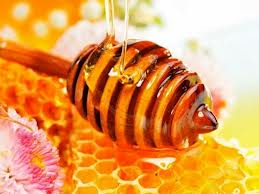Honey was a conventional therapy for infection up until the early 20th century when penicillin became the mainstream choice

Refined /heat-processed, domestic "Grade A"honey may actually increase infection;
Excessive heat-processing destroys natural enzymes and vitamins
Filtering removes phytonutrients. Such as pollen and propolis
Osmolarity of sugar in honey. This alone prevents microbial growth
Honey has a low water activity (aw) of ~0.6, which prevents growth of most microorganisms (bacteria with aw > 0.9, or fungi with aw at least 0.7). Higher aw substances tend to support more microorganisms. Water migrates from areas of high wa to low wa. So honey exposed to humid air (aw ~0.7) absorbs its water. Salami (aw ~0.87) exposed to dry air (aw ~ 0.5) dries out the salami. Wikipedia
Most of the water molecules in honey are associated with the sugars, leaving few available for microorganisms and making a poor environment for microbial growth. However, if water is mixed with honey it loses this antimicrobial growth property. (Lansing, 1999)
Acidity of honey. Honey has a relatively acidic pH usually 3.2 - 4.5 which prevents the growth of many bacteria. Honey as an Antimicrobial Agent
In wounds, slow release of hydrogen peroxide (catalyzed by the enzyme glucose oxidase present in honey).
• Glucose oxidase is only activated when acidity of honey is diluted by body fluids in the presence of oxygen
• Glucose oxidase can be destroyed by the protein-digesting enzymes present in wound fluids and when honey is exposed to heat and light. Waikato Honey Research
C6H12O6 (glucose) + H2O + O2 → C6H12O7 + H2O2 (glucose oxidase reaction)
In Manuka Honey, the antibacterial activity of methylglyoxal (MGO) plus an unidentified synergistic component called Unique Manuka Factor (UMF). Most honeys contain very low levels of MGO, but manuka honey contains very high levels. The presence of the synergist in manuka honey more than doubles MGO antibacterial activity. Waikato Honey Research; Kwakman, 2011)
Antibacterial activity in Manuka honey is 100 times more powerful than in others. Manuka honey has more potent antibacterial ingredients than other raw honeys
• Made by bees from pollen gathered from flowers of the manuka bush in New Zealand;
• Has super potency and healing properties compared to other raw honey. Manuka has an ingredient called the Unique Manuka Factor (UMF), which has antimicrobial qualities. Each batch has varying amounts of UMF, and higher concentrations increase thickness, shade of darkness and price.
Honey chelates and deactivates free iron, averting radical formation with consequential inflammation. Iron is otherwise able to catalyse the formation of oxygen radicals from hydrogen peroxide, leading to inflammation
Flavonoid antioxidant constituents in honey can neutralize oxygen radicals
• Pinocembrin (possibly unique to honey)
• Pinostrobin. Supports enzyme acitivity Honey as a topical antibacterial agent for treatment of infected wounds
Honey as an Antimicrobial Agent. Waikato Honey Research Unit. November 16, 2006.
Kwakman PHS, te Velde AA, de Boer L, Vandenbroucke-Grauls CMJE, Zaat SAJ (2011). "Two major medicinal honeys have different mechanisms of bactericidal activity". PLoS ONE pdf PubMed
Lansing Prescott, John P. Harley, Donald A. Klein (1999) Microbiology. Boston: WCB/McGraw-Hill.ISBN0-697-35439-3.
"Waikato Honey Research Unit:What's special about Active Manuka Honey?". The University of Waikato. Retrieved 05-02-2011.